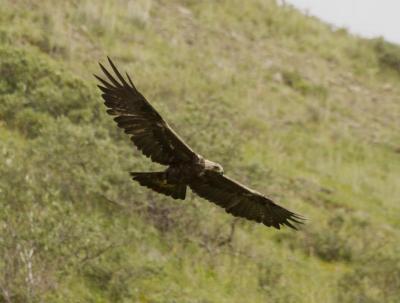FROSTBURG, MD (September 28)--Roughly over a quarter of the golden eagles killed at the Altamont Pass Wind Resource Area in Northern California from 2012-2014 were recent immigrants to the local population, according to research led by the U.S. Geological Survey. The results illustrate how golden eagle populations are interconnected across the western U.S. and suggest that golden eagle deaths, or mitigation for those deaths, at one location may impact populations in other areas.
 Golden eagles in North America are protected by the Bald and Golden Eagle Protection Act, the Migratory Bird Treaty Act and numerous other state, provincial and national regulations. Few wind energy development environmental assessment or mitigation plans consider consequences beyond local populations and ecosystems.
Golden eagles in North America are protected by the Bald and Golden Eagle Protection Act, the Migratory Bird Treaty Act and numerous other state, provincial and national regulations. Few wind energy development environmental assessment or mitigation plans consider consequences beyond local populations and ecosystems.
“The results of our work here show golden eagle populations of the Altamont Pass Wind Resource Area are sustained by immigration from elsewhere in North America,” said Todd Katzner, USGS wildlife biologist and lead author of a new article describing the study published in the journal Conservation Biology. “This discovery provides important perspectives on management of golden eagle populations. Mitigation for turbine-associated death could occur in other parts of the western U.S. and provide local benefit to the interconnected population.”
A team of scientists including David Nelson and Matthew Fitzpatrick from the University of Maryland Center for Environmental Science's Appalachian Laboratory collected age, genetic and stable isotope information from 67 eagles killed at the Altamont Pass Wind Resource Area from 2012-2014. Using data from stable hydrogen isotopes, a form of hydrogen that does not change over time and differs from location to location, scientists were able to link the region where the eagles grew their feathers to the location they were killed; they found they were not always the same.
“Stable hydrogen isotope analyses conducted on eagle feathers clearly show that at least 26 percent of the individuals killed at APWRA were recent long-distance immigrants to the population, most from distances over 62 miles away,” said David Nelson, head of the Central Appalachian Stable Isotope Facility at the University of Maryland Center for Environmental Science, and co-author on the paper.
 In contrast to the stable isotope data, the research team detected only limited genetic differences in these eagles.
In contrast to the stable isotope data, the research team detected only limited genetic differences in these eagles.
“We detected no differences in genes among local and recent immigrant eagles,” said J. Andrew DeWoody, Professor of Genetics at Purdue University and co-author of the study. “Together, the stable isotope and genetics data indicate that eagle populations are connected across much of North America and often travel long distances.”
Golden eagle deaths from any source, as well as management to help eagles, not only have consequences for local populations, but can affect golden eagles across a great portion of their continental range. Eagles are top predators and changes to their populations can have ecosystem-wide impacts. The results of this study are relevant to understanding the biology of golden eagle populations, national and global conservation of golden eagles and effective continental-scale management of renewable energy development.
This study includes scientists from the USGS, University of Maryland Center for Environmental Science, West Virginia University, Purdue University, Western Foundation of Vertebrate Zoology, and the wind industry. Funding was provided by the Bureau of Land Management, California Department of Fish and Wildlife, the U.S. Fish and Wildlife Service and the individual scientists’ institutions.
The study, “Golden Eagle fatalities and the continental-scale consequences of local wind-energy generation,” was published authors including David Nelson and Matthew Fitzpatrick of the University of Maryland Center for Environmental Science in Conservation Biology.
UNIVERSITY OF MARYLAND CENTER FOR ENVIRONMENTAL SCIENCE
The University of Maryland Center for Environmental Science leads the way toward better management of Maryland’s natural resources and the protection and restoration of the Chesapeake Bay. From a network of laboratories located across the state, UMCES scientists provide sound advice to help state and national leaders manage the environment, and prepare future scientists to meet the global challenges of the 21st century.
# # #
Photos by Todd Katzner/USGS

